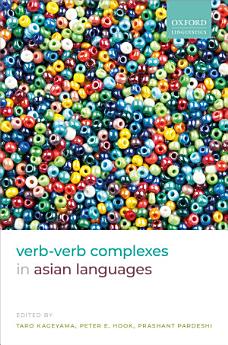Verb-Verb Complexes in Asian Languages
Taro Kageyama · Peter E. Hook · Prashant Pardeshi
ਫ਼ਰ 2021 · Oxford University Press
ਈ-ਕਿਤਾਬ
624
ਪੰਨੇ
family_home
ਯੋਗ
info
reportਰੇਟਿੰਗਾਂ ਅਤੇ ਸਮੀਖਿਆਵਾਂ ਦੀ ਪੁਸ਼ਟੀ ਨਹੀਂ ਕੀਤੀ ਗਈ ਹੈ ਹੋਰ ਜਾਣੋ
ਇਸ ਈ-ਕਿਤਾਬ ਬਾਰੇ
This volume is the first to present a detailed survey of the systems of verb-verb complexes in Asian languages from both a synchronic and diachronic perspective. Many Asian languages share, to a greater or lesser extent, a unique class of compound verbs consisting of a main verb and a quasi-auxiliary verb known as a 'vector' or 'explicator'. These quasi-auxiliary verbs exhibit unique grammatical behaviour that suggests that they have an intermediate status between full lexical verbs and wholly reduced auxiliaries. They are also semantically unique, in that when they are combined with main verbs, they can convey a rich variety of functional meanings beyond the traditional notions of tense, aspect, and modality, such as manner and intensity of action, benefaction for speaker or hearer, and polite or derogatory styles in speech. In this book, leading specialists in a range of Asian languages offer an in-depth analysis of the long-standing questions relating to the diachrony and geographical distribution of verb-verb complexes. The findings have implications for the general understanding of the grammaticalization of verb categories, complex predicate formation, aktionsart and event semantics, the morphology-syntax-semantics interface, areal linguistics, and typology.
ਲੇਖਕ ਬਾਰੇ
Taro Kageyama is Professor Emeritus at the National Institute for Japanese Language and Linguistics, where he was Director General from 2009-2017, and a former President of the Linguistic Society of Japan. He is the author or (co-)editor of about 40 books in the fields of word formation, morphology, lexical semantics, and syntax, with special reference to Japanese and English, including Handbook of Japanese Lexicon and Word Formation (De Gruyter, 2016) and Handbook of Japanese Contrastive Linguistics (De Gruyter, 2018). Peter E. Hook is Professor Emeritus in the Department of Asian Languages and Cultures at the University of Michigan. His research primarily explores the syntax, semantics, and grammaticalization of compound verbs and other grammatical phenomena in Hindi-Urdu and other Indo-Aryan languages and dialects. His publications include articles in journals such as Linguistics, Yearbook of South Asian Languages and Linguistics, and South Asia Yearbook. Prashant Pardeshi is a Professor in the Division of Linguistic Theory and Typology at the National Institute for Japanese Language and Linguistics. He is interested in functional linguistic typology, comparative studies between Japanese and Indian languages, Japanese language pedagogy, and lexicography. He has published numerous articles in edited volumes and international journals such as Linguistics, Journal of Japanese Linguistics, and Acta Linguistica Asiatica.
ਇਸ ਈ-ਕਿਤਾਬ ਨੂੰ ਰੇਟ ਕਰੋ
ਆਪਣੇ ਵਿਚਾਰ ਦੱਸੋ
ਪੜ੍ਹਨ ਸੰਬੰਧੀ ਜਾਣਕਾਰੀ
ਸਮਾਰਟਫ਼ੋਨ ਅਤੇ ਟੈਬਲੈੱਟ
Google Play Books ਐਪ ਨੂੰ Android ਅਤੇ iPad/iPhone ਲਈ ਸਥਾਪਤ ਕਰੋ। ਇਹ ਤੁਹਾਡੇ ਖਾਤੇ ਨਾਲ ਸਵੈਚਲਿਤ ਤੌਰ 'ਤੇ ਸਿੰਕ ਕਰਦੀ ਹੈ ਅਤੇ ਤੁਹਾਨੂੰ ਕਿਤੋਂ ਵੀ ਆਨਲਾਈਨ ਜਾਂ ਆਫ਼ਲਾਈਨ ਪੜ੍ਹਨ ਦਿੰਦੀ ਹੈ।
ਲੈਪਟਾਪ ਅਤੇ ਕੰਪਿਊਟਰ
ਤੁਸੀਂ ਆਪਣੇ ਕੰਪਿਊਟਰ ਦਾ ਵੈੱਬ ਬ੍ਰਾਊਜ਼ਰ ਵਰਤਦੇ ਹੋਏ Google Play 'ਤੇ ਖਰੀਦੀਆਂ ਗਈਆਂ ਆਡੀਓ-ਕਿਤਾਬਾਂ ਸੁਣ ਸਕਦੇ ਹੋ।
eReaders ਅਤੇ ਹੋਰ ਡੀਵਾਈਸਾਂ
e-ink ਡੀਵਾਈਸਾਂ 'ਤੇ ਪੜ੍ਹਨ ਲਈ ਜਿਵੇਂ Kobo eReaders, ਤੁਹਾਨੂੰ ਫ਼ਾਈਲ ਡਾਊਨਲੋਡ ਕਰਨ ਅਤੇ ਇਸਨੂੰ ਆਪਣੇ ਡੀਵਾਈਸ 'ਤੇ ਟ੍ਰਾਂਸਫਰ ਕਰਨ ਦੀ ਲੋੜ ਹੋਵੇਗੀ। ਸਮਰਥਿਤ eReaders 'ਤੇ ਫ਼ਾਈਲਾਂ ਟ੍ਰਾਂਸਫਰ ਕਰਨ ਲਈ ਵੇਰਵੇ ਸਹਿਤ ਮਦਦ ਕੇਂਦਰ ਹਿਦਾਇਤਾਂ ਦੀ ਪਾਲਣਾ ਕਰੋ।







